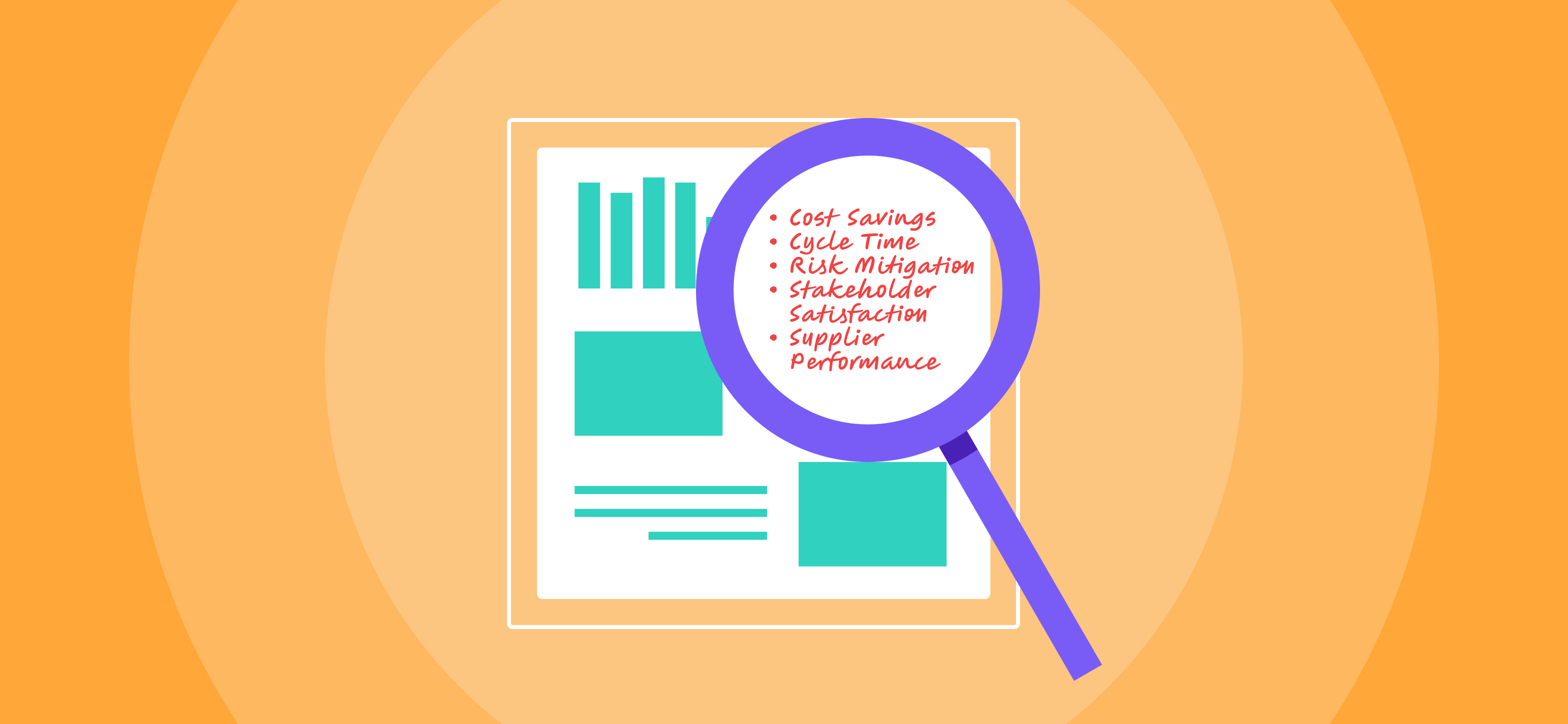My good friend Chandhrika Venkataraman and I see this dilemma far too often: Procurement achieves strong results for the organization, but the CFO is still disappointed.
The worst part? It’s procurement’s fault, often stemming from a lack of strong data to set proper expectations with stakeholders.
Conducting a spend analysis for procurement can mitigate this scenario as it supports smarter financial decision-making. By gathering and analyzing spend data, companies can uncover cost-saving opportunities, identify trends, and manage suppliers more effectively. Simply put, you’ll get a clearer picture of how your dollars are being spent and where it’s headed.
To better illustrate this, let’s look at how procurement can leverage data to gain stakeholder alignment through the lens of a common hypothetical scenario:
.avif)
Hitting a goal only to have the target increase next quarter is not necessarily a bad concept. It’s based on the idea that efficiencies mean you can improve over time. But what often happens in procurement? The function adopts a customer service mindset. While keeping stakeholders first is important, procurement tends to jump the gun.
Always looking to please and deliver value, Arnold and the team commit to the cause and push hard in negotiations. Yet as Q1 progresses, things are looking grim (at least compared to their new goal of $1.2M). They over-deliver on a few big projects but by the end of the quarter, they have achieved total savings of $850K…that's $350K short of the goal.
The team is tired. Arnold is frustrated. And the CFO is not happy.
Here’s what procurement should have done
Before committing to a new savings target, Arnold should have leveraged a spend analysis to gain alignment with his CFO up front. First, he needs to determine if there even is pipeline (demand) to hit such a savings number. Assuming Arnold has most of his spend under management, his demand for Q1 is equal to:
- Expiring contracts that will be replaced with a new contract (either incumbent or competitor)
- New spend that has been budgeted and approved
- Possibly some “surprise” spend that has popped up (he likely won’t have visibility to this)
Dig into the spend data
Based on historical industry trends, Q4 tends to be a heavy spend quarter while Q1 tends to be a little lighter.
But that alone is not sufficient to determine if he’s set up for failure or not. Let’s say that the total spend in Q4 looked something like this.

Forecasted spend was $9.3M but the baseline increased to $10.0M with some unplanned spend. As a result of Arnold’s team’s involvement, actual spend totaled $9.0M and generated a savings of $1M against the baseline.
Now, let's pretend that when the CFO assigned a savings goal of $1.2M for Q1, Arnold pushes back (in a constructive and professional way) using data. He shows his CFO that:
- Average savings for Q4 was 6.7% for expiring contracts and 18% for new spend
- Savings for surprise spend was less than 1% (mostly because the turnaround time was so quick and the possibly of leveraging alternatives was nearly zero)
Provide an updated forecast
Finally, he presents an updated data-backed forecast for Q1, which consists of only $4.3M in expiring spend and $2.9M in new budgeted spend.

Considering the above, a more realistic expectation would be $810K of savings (not $1.2M) when applying the same savings percentage that was achieved in Q4. With this expectation, procurement actually performed better than they should have by driving $850K of savings.
.avif)
Here’s how procurement can drive even more value
Few things are more frustrating for procurement than being underappreciated for their efforts.
But don’t blame the CFO. Arnold did not appropriately set expectations with his CFO, so blame procurement.
The reality is that two procurement professionals can achieve the same results. However, one is perceived as a value-added partner and the other as a back-office function that fails to achieve desired outcomes. The difference? The one perceived as a value-added partner uses data to gain alignment and set expectations up front, even proactively presenting options to the stakeholder.
In fact, presenting options is a strategy Chandhrika uses all the time. She doesn’t just show the data and force the stakeholder to accept the situation. Rather, she puts them in the driver's seat by showing them different avenues the company could take based on the data.
.avif)
Determine your options
I’ve employed this technique in a recent negotiation. I understood that the stakeholder had a tight budget of about $40K. I also had data that suggested that I might be able to get an impressive 50% discount with the current supplier if I leveraged all my negotiation techniques – the problem is that even with this discount, we’d still be over budget by about $10K given the supplier’s annual uplifts.
With that intel, here are the possible options the company could take:
Option A: Look at other suppliers to stay under the $40K budget
While it’s important to source and find the right features for your needs, it’s equally important to consider migration fees and time when transitioning to a new provider. Investigate questions like:
- How is the service level compared to the current supplier?
- How long does onboarding and training take?
- Does my team have the bandwidth to onboard, learn, and train a new system?
Option B: Stay with the incumbent solution but end up $10-15K over budget
Make it clear to your stakeholder that staying with the incumbent solution means you will be over budget regardless of any discounts you may be able to negotiate. Often this will become a conversation about how much your team is using this tool and whether or not features fit needs. Investigate questions like:
- What are utilization rates in the past X months for this tool?
- Does my team enjoy using this tool? Anything that could make it better?
Use those options to put your stakeholder in the driver’s seat
Without setting expectations appropriately, I might have returned with my 50% discount only to have the stakeholder say something like, “I don’t know, it’s still above budget. Maybe I should have just negotiated myself.”
But we’re doing this the right way and aligning with our stakeholder up front. Using Chandhrika’s strategy, I proactively went to the stakeholder before I started any negotiations.
.avif)
Here’s how I presented both options:
“Look, I’ve benchmarked XYZ solution and talked to several other customers. Check out this data: It shows that a 50% discount would be a very impressive feat, but 40% is much more likely. Even with these discounts, we’d still end up over budget. So we can either look at other providers if you really need to get down to that $40K budget OR stay with the incumbent but still end up $10-15K above your budget.”
I proceeded to explain that I did some initial research and found that competitor XYZ could likely achieve our cost goal but tends to have a lower service level. Additionally, the transition would take about 6 weeks and require a sizable chunk of time from at least 2 of your team members. Then I asked the stakeholder:
“Based on this data, how would you like me to proceed?”
After mulling it over, the stakeholder said, “You know the team has been through a lot of change recently and they really like this tool. We think it will deliver higher ROI. What I heard you say is that a 40% discount with the incumbent is likely but a 50% might be possible. It would mean a lot if you can do everything you can to achieve the 50% discount and I’ll go to finance to try and work out the difference.”
Data and communication are your keys to gaining alignment
Even though I came back over budget, the stakeholder was thrilled that we were able to achieve the 50% discount. More importantly, he trusted me as a strategic advisor who could help him achieve good results and accurately forecast the financial situation using data. He started working more proactively with me on future spend.
.avif)
Regarding Arnold’s scenario, his CFO likely would have accepted $810K as a goal based on the data presented. It's also possible, she would have issued a stretch goal of $825K or $850K.
If Arnold is really on his procurement game, he will take the spend analysis further. He could have looked at some of the major opportunities in Q1 and suggested something like, “If we are going to get above $800K in a meaningful way, I have two ideas.”
Then they could jointly explore other levers such as sourcing (and possibly switching suppliers) or looking at utilization (increasing the acceptable usage threshold). They could also discuss the trade-offs and support needed to make this effort a reality.
The combination of strong data and excellent communication is a phenomenal way to elevate procurement and turn it into a strategic partner.
If you're interested in seeing how Tropic bridges the gap between your finance and procurement functions and helps your team gain greater insight into your spend, learn more here.
Related blogs
Discover why hundreds of companies choose Tropic to gain visibility and control of their spend.








